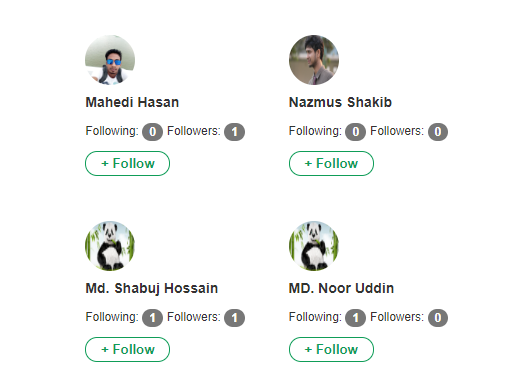Hi Dev,
This comprehensive guide covers a User Follow Unfollow System in Laravel 9. Whether you're building a social network or enhancing user interaction, this step-by-step Laravel 9 tutorial using AJAX and jQuery will help you implement Follow/Unfollow functionality seamlessly.
This tutorial demonstrates how to:
- Install Laravel Follow System using
overtrue/laravel-followpackage - Build follow and unfollow buttons with AJAX and jQuery
- Manage user relationships dynamically without page refresh
- Display followers and following with real-time updates
Preview :

Follow the steps below to build a real-time follow/unfollow system in Laravel 9. You can also download the full script from the link provided at the end.
Step 1: Download LaravelLet us begin the tutorial by installing a new laravel application. if you have already created the project, then skip following step.
composer create-project laravel/laravel example-appStep 2 : Install overtrue/laravel-follow Package
Now we need to install laravel-follow package for follow unfollow system. So Open your terminal and run the bellow command.
composer require overtrue/laravel-follow -vvv
Now open the config/app.php file and add service provider and alias.
config/app.php
'providers' => [
Overtrue\LaravelFollow\FollowServiceProvider::class,
],
To publish the migrations file run bellow command
php artisan vendor:publish --provider='Overtrue\LaravelFollow\FollowServiceProvider' --tag="migrations"
As optional if you want to modify the default configuration, you can publish the configuration file:
php artisan vendor:publish --provider="Overtrue\LaravelFollow\FollowServiceProvider" --tag="config"
Then just migrate it by using the following command:
php artisan migrateStep 3 : Create Authentication
In this step, we require to create authentication of Laravel 9, so laravel provides an artisan command to create authentication that way we don't require to create a route and controller for login and registration. so run bellow command:
php artisan make:authStep 4 : Create Dummy Users
In this step, we will create some dummy users for testing, so we will create dummy users using the formate factory. so run the below command:
php artisan tinker factory(App\User::class, 100)->create();Step 5 : Update User Model
here we need to update the User model. we need to use the CanLike trait in the User model. So let's update as bellow code.
App/User.php
namespace App;
use Illuminate\Notifications\Notifiable;
use Illuminate\Foundation\Auth\User as Authenticatable;
use Overtrue\LaravelFollow\Traits\CanFollow;
use Overtrue\LaravelFollow\Traits\CanBeFollowed;
class User extends Authenticatable
{
use Notifiable, CanFollow, CanBeFollowed; //See we used CanFollow and CanBeFollowed Traits
protected $fillable = [
'name', 'email', 'password',
];
protected $hidden = [
'password', 'remember_token',
];
}
Step 6 : Add Routes
In this step, we will create routes for follow, unfollow system in Laravel. So we require to create the following route in the web.php file.
routes/web.php
Route::get('users', 'HomeController@users')->name('users');
Route::get('user/{id}', 'HomeController@user')->name('user.view');
Route::post('follow', 'HomeController@follwUserRequest')->name('follow');
Step 7 : Create Controller Method
now in HomeController, we will add three new method users(), user() and ajaxRequest(). so let's see HomeController like as bellow:
app/Http/HomeController.php
namespace App\Http\Controllers;
use Illuminate\Http\Request;
use App\User;
class HomeController extends Controller
{
public function __construct()
{
$this->middleware('auth');
}
public function index()
{
return view('home');
}
public function users()
{
$users = User::get();
return view('users', compact('users'));
}
public function user($id)
{
$user = User::find($id);
return view('usersView', compact('user'));
}
public function follwUserRequest(Request $request){
$user = User::find($request->user_id);
$response = auth()->user()->toggleFollow($user);
return response()->json(['success'=>$response]);
}
}
Step 8 : Create Blade files and JS File
Now in this file, we will need to create userList.blade.php, users.blade.php, and usersView.blade.php files and custom.js file. So let's create both files.
resources/views/users.blade.php
@extends('layouts.app')
@section('content')
<script src="{{ asset('js/custom.js') }}" defer></script>
<div class="container">
<div class="row justify-content-center">
<div class="col-md-12">
<div class="card">
<div class="card-header">List of Users- Codechief.org</div>
<div class="card-body">
<div class="row pl-5">
@include('userList', ['users'=>$users])
</div>
</div>
</div>
</div>
</div>
</div>
@endsection
resources/views/usersView.blade.php
@extends('layouts.app')
@section('content')
<script src="{{ asset('js/custom.js') }}" defer></script>
<div class="container">
<div class="row justify-content-center">
<div class="col-md-12">
<div class="card">
<div class="card-header">
{{ $user->name }}
<br/>
<small>
<strong>Website:</strong> Codechief.org,
<strong>Email: </strong>{{ $user->email }}
</small>
</div>
<div class="card-body">
<nav>
<div class="nav nav-tabs" id="nav-tab" role="tablist">
<a class="nav-item nav-link active" id="nav-home-tab" data-toggle="tab" href="#followers" role="tab" aria-controls="nav-home" aria-selected="true">Followers <span class="badge badge-primary">{{ $user->followers()->get()->count() }}</span></a>
<a class="nav-item nav-link" id="nav-profile-tab" data-toggle="tab" href="#following" role="tab" aria-controls="nav-profile" aria-selected="false">Following <span class="badge badge-primary">{{ $user->followings()->get()->count() }}</span></a>
</div>
</nav>
<div class="tab-content" id="nav-tabContent">
<div class="tab-pane fade show active" id="followers" role="tabpanel" aria-labelledby="nav-home-tab">
<div class="row pl-5">
@include('userList', ['users'=>$user->followers()->get()])
</div>
</div>
<div class="tab-pane fade" id="following" role="tabpanel" aria-labelledby="nav-profile-tab">
<div class="row pl-5">
@include('userList', ['users'=>$user->followings()->get()])
</div>
</div>
</div>
</div>
</div>
</div>
</div>
</div>
@endsection
resources/views/userList.blade.php
@if($users->count())
@foreach($users as $user)
<div class="col-2 profile-box border p-1 rounded text-center bg-light mr-4 mt-3">
<img src="https://www.codechief.org/user/img/user.jpg" style="height: 50px; width: 50px; border-radius: 50%;" class="img-responsive">
<h5 class="m-0"><a href="{{ route('user.view', $user->id) }}"><strong>{{ $user->name }}</strong></a></h5>
<p class="mb-2">
<small>Following: <span class="badge badge-primary">{{ $user->followings()->get()->count() }}</span></small>
<small>Followers: <span class="badge badge-primary tl-follower">{{ $user->followers()->get()->count() }}</span></small>
</p>
<button class="btn btn-info btn-sm action-follow" data-id="{{ $user->id }}"><strong>
@if(auth()->user()->isFollowing($user))
UnFollow
@else
Follow
@endif
</strong></button>
</div>
@endforeach
@endif
publis/js/custom.js
$(document).ready(function() {
$.ajaxSetup({
headers: {
'X-CSRF-TOKEN': $('meta[name="csrf-token"]').attr('content')
}
});
$('.action-follow').click(function(){
var user_id = $(this).data('id');
var cObj = $(this);
var c = $(this).parent("div").find(".tl-follower").text();
$.ajax({
type:'POST',
url:'/follow',
data:{user_id:user_id},
success:function(data){
console.log(data.success);
if(jQuery.isEmptyObject(data.success.attached)){
cObj.find("strong").text("Follow");
cObj.parent("div").find(".tl-follower").text(parseInt(c)-1);
}else{
cObj.find("strong").text("UnFollow");
cObj.parent("div").find(".tl-follower").text(parseInt(c)+1);
}
}
});
});
});
📌 FAQs
- Q: How do I create a user follow system in Laravel 9?
A: You can use theovertrue/laravel-followpackage along with AJAX to implement a dynamic follow/unfollow system. - Q: Can I use this tutorial in Laravel 10?
A: Yes, with minor adjustments, this guide is compatible with Laravel 10 as well. - Q: How do I show user followers and following?
A: Use$user->followers()and$user->followings()methods to retrieve related data. - Q: Is the AJAX follow/unfollow button secure?
A: Yes, it's protected using Laravel CSRF token and middleware authentication. - Q: How can I add a notification when someone follows?
A: You can trigger Laravel Notifications on thefollowedevent.